
Venereal Disease Treatment Menu: 1 2 3 4 5 6 7 8 9 10 11 12 13 14 <<First
Venereal Diseases in the Golden Age of Piracy, Page 14
Treating VD During the GAoP: Second Stage (Confirmed Pox) - Stopping Salivation
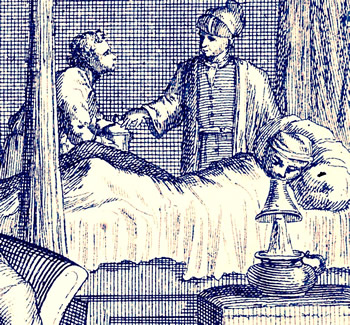
The Scourge of Venus and Mercury,
John Sintelaer, frontispiece (1709)
If all went well, a salivation would end on its own. Sea surgeon John Atkins notes, "A Flux that has advanced kindly to its Height, will as gradually decline"1. However, Atkins also notes that "Our bad Nursing on board of Ships in this Case prolong their Expuition [spitting], and take up more Time for recovering"2. Such cases might require the surgeon to end the salivation.
When a salivation had to be terminated forcibly, purging medicines seem to have been the drug of choice. Matthias Gottfried Purmann says that if salivation goes on too long, "give the Patient a gentle Purge, let him drink Beer again, use an Astringing Gargarism, change the Sheets of his Bed, and then it will cease."3 Sea surgeon John Atkins recommends that the surgeon keep an eye on the patient to make sure that his "Constitution and Courage will support him thro’ the Course; because now, if the Success is doubted, we may safely divert with Catharticks [purges]"4. Since purging medicines were already discussed in detail, the exercise of reviewing them is left to the reader.
1 John Atkins, Lues Venerea, not dated, p. 45; 2 John Atkins, The Navy Surgeon, 1742, p. 246; 3 Matthias Gottfried Purmann, Churgia Curiosa, 1706, p. 195; 4 Atkins, Navy Surgeon, p. 243
Treating VD During the GAoP: Second Stage (Confirmed Pox) - Post-Salivation
There were other procedures and concerns to be administered by the surgeon once a salivation has finished. Sea surgeon John Atkins mentions that the patient will be faint and debilitated "out of Necessity" because of the stress of salivation and his meager diet. Atkins says, "The Patient must be altogether confined to the Bed; he must be kept between the Blankets". Part of this is to allow him to rebuild his strength and part of it is to keep the patient warm. However, the two primary concerns of the surgeon once salivation ended were purging the mercury used to raise a salivation from the patient's body and healing their mouth which typically became irritated during the treatment.
Post-Salivation in a Confirmed Pox: Purging Mercury from the Patient's Body
Once salivation finished, it was felt to be necessary to purge the mercury from the patient's body. Sea surgeon John Atkins explains that "the close of it [the salivation] calls for Physick [medicines] and Diet Drink, to expel the Remains and Recrements of the Mercury"1. He notes that salivation combined with twitching "might continue an inconvenient length. if the Humours were not diverted, and the Ulcerations dried in the end, by Enema's,

Photo: Wiki User Lalithamba - Senna Alexandrina, Nellore, India
Catharticks [purges] and Gargles."2 While Atkins mentions enemas here, he doesn't provide any specific prescriptions. Gargles were used to treat sores and ulcers of the mouth which will be discussed in the next section.
Atkin's use of cathartics or stomach purges is significant; purging at the end of a treatment was thought to help eject the mercury from the patient. German surgeon Matthias Gottfried Purmann also recommends, "though the Flux has gone off very well, yet the Patient must be purged well afterwards... that none of the Mercury or the Disease may remain behind."3 In his case study, sea surgeon John Moyle mentions that once the patient's "spitting wholly ceased... I gave him a gentle Purge of Senna & Rhubarb"4. Senna was considered a fairly mild purge, while rhubarb seems to have varied between mild and regular in its purging ability. Many other specific purges have already been discussed in detail in the section on using purges while treating a confirmed pox.
Everyone under study advises giving the patient diet drinks, which, as explained previously, contain a large number of sudorific medicines to cause sweating.
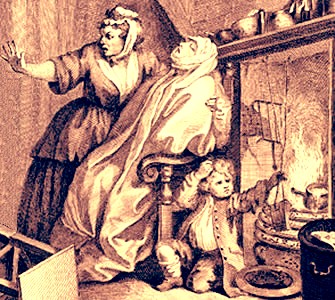
Artist: William Hogarth
Sweating a Pox Patient, From A Harlot's Progress, Scene 2 (1732)
Like the stomach purges, sweating was thought to be a way to eject the mercury from the body. Sea surgeon John Moyle tied sweating directly to salivation.5 Purmann mentions that, in addition to giving purge, once salivation has stopped, the patient should be "sweated four or five times in Balneum Laconicum [sweating room] with Spirit of Wine" to help remove the mercury.6
While Atkins approves of diet drinks to cause a sweat and remove mercury, he gives them a wider scope of impact, explaining that the diet drinks, enemas and purges "subdue and carry off the Remnants of the Mercury, heal the Excoriations of the Mouth, and [the diet] Drinks, in particular correct the Acidities of the Blood, and procure a gentle Diaphoresis [sweating], which very much avails in finishing a Removal of all Pains.7 However, his explanation of the use of diet drinks suggests their primary benefit was in pushing the 'acidities of the blood' out of the body via the sweat glands. Atkins advises using diet drinks for this purpose for six to eight weeks.
1,2 John Atkins, Lues Venerea, not dated, p. 45; 3 Matthias Gottfried Purmann, Churgia Curiosa, 1706, p. 195; 4 John Moyle, Memoirs: Of many Extraordinary Cures, 1708, p. 89; 5 John Moyle, Chirugius Marinus: Or, The Sea Chirurgeon, 1693, p. 143; 6 Purmann, p. 195; 7 Atkins, p. 46
Post-Salivation in a Confirmed Pox: Treating the Patient's Mouth
A big problem for patients being salivated was soreness, swelling and even ulcers in the mouth. Sea surgeon John Atkins explains that once salivation using topical mercury begins, "there should be more than ordinary Pain in the Jaws and Mouth, and the Saliva running off bloody, we are not always to be startled at it; they are the common Attendants of Mercury, and reach no farther than the Parts immediately
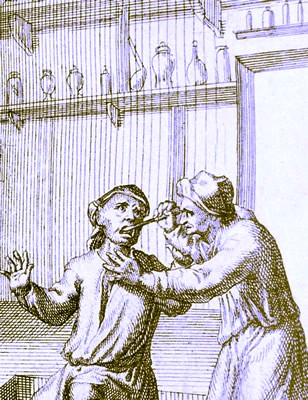
Treating Mouth Wounds, From
The Scourge of Venus and
Mercury,
By John Sintelaer, frontispiece (1709)
affected"1. If this becomes troublesome, he suggests stopping the mercury for a day which should "in a great Measure correct such Uneasiness; and to prevent their Return and Aggravation"2. Atkins elsewhere suggests that sores in the mouth reveal the "Power and Evil of Mercury"3.
Although mercury does increase salivation, soreness, bleeding or ulcers in the mouth are not symptoms recognized today as a sign of mercury poisoning. Increased salivation could contribute to soreness and similar problems. In addition, a sore throat is one possible symptom of syphilis and ulcers in the form of gummas, which can appear anywhere on the body including in the mouth. So syphilis may be the more likely culprit here.
Soreness in the mouth could occur both during salivation treatment and afterwards. Atkins suggests heading off such problems by making sure that the patient's mouth is "frequently washed with the Liquors they drink, to cleanse and scour the Glands from Filth, that they may the more freely spue out their Contents."4 He explains that the patient will be thirsty throughout salivation, so the surgeon should make sure to have plenty of diet drink ready for their use, which "should be used warm, because Cold (in this general Ulceration of the Mouth) would create great Pain, check the Flux, and hazard the falling out of the Teeth."5
The importance that surgeons during the golden age of piracy assigned to keeping the patient warm while salivating him has already been noted. However, Atkins discusses the influence of cold on problems with the mouth at some length. He says that cold slows the process of salivating, "the whole Mouth apostemating as it were, with more Pains and Swelling than should be. The Remedies are redoubling the Warmth, particularly about the Fauces. [throat] Cardiacks [purging medicines] and proper Sustanance to assist the Suppuration, which with Gargles"6. He further explains that the impact of cold depends upon "the Tenderness of one Patient beyond another, on whom cold Air more easily impresses its Effect on the excoriated Glands;
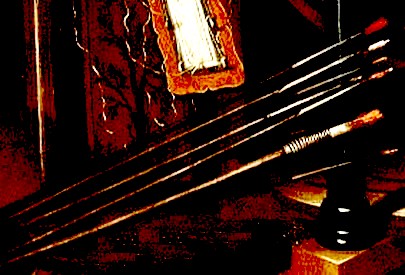
Artist: Bartolomeo Bettera - GAoP 'Pencils',
A painters brushes, (17th c.)
whereby Salivation stops, or declines hastily and irregularly, with painful Apostemations about the Mouth and Jaws."7
As with most of the venereal disease treatments, the cure of such problems of the mouth relied on medicines. Matthias Gottfried Purmann recommended that when treating a patient's mouth during salivation, the surgeon should "Syringe his Mouth with a cleaning Gargarism, and keep the Teeth and Gums clean with a Pencil."8 Unfortunately, Purmann doesn't specify a particular cleaning gargle. In addition, his a pencil does not refer to the lead-based writing instruments we think of today, but a brush. A period dictionary defines a pencil as "a small Instrument, made of Bears, Ermins, or Hogs-Hairs put into Quills of several Sizes, to be us'd in Drawing, Painting, &c."9
Atkins suggests two gargles for treating swelling and soreness in the mouth. They include:

Photo: Giancarlo Dessi - Myrtle Berries (Myrtus communis)
Rx. Aq. Rosar. [rose water] Plantag. [plantane water] {of each, 3 ounces} Mell. Rosar. [honey of roses] {1 ounce} Ol. vit[riol]. {6 drops} pro Gargarism. [for a gargle] ad os eluendum. [to rinse the mouth]
Rx. Fol. Plantag. [plantane leaves] Myrtill. in Aq. Hord. [barley water] decoct. [boil] Colatur. [strain] {8 ounces} adde Syr[up]. [d]é Moris {1 ounce} M. [mix] F. Gargarism. [make into a gargle]”10
Plantane was specifically recognized for its ability to stop flows, in this case suggesting stopping salivation. Roses were believed to be astringent - able to contract tissues in the body - and honey of roses in particular was used in gargles to cure ulcers in the mouth and throat. Myrtle berries were also astringent and also used to stop flowing fluids. Syrup de Moris contained mulberries and was often used in gargles because of its astringent properties. Oil of vitriol was believed to cure ulcers, among other things. Barley was said to be nourishing and lubricating, which would likely make swallowing easier.
Sea surgeon John Moyle also provides some prescriptions for medicines to treat a sore mouth and swollen jaws after salivation. Unlike Atkins' gargles, these include a bolus (dose of chewable medicine) and a haustus (dose of liquid medicine). He explains that "Either of these will carry gently downward [purge], and preserve, that the Mouth and Jawes shall not be too much
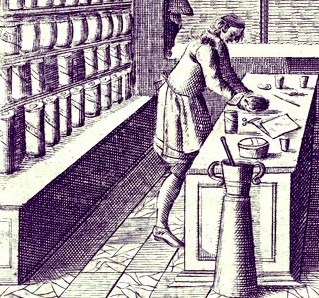
Apothecary at Work, From Georgica Curiosa Aucta,
By Wolfgang Helmhard Hohberg (1697)
annoyed and made sore, with the Attoms of the Medicine. And this will not hinder the Salivation, but it will rise more kindly a little after."11
Rx. Electuar[y]. Cathol[icum]. {1 ounce} Razin. Julap {5 grains} misce, f. Bolus. [mix and make into a bolus] Or,
Rx. Syr[up]. Rosar[um]. solut[ive]. cum Senna {1 ounce} decoct. Senna Gereonis [Gereon's Purging Decoction of Sena] {2 ounces} misce, f. Haustus. [mix and make into a haustus]12
As Moyle promises, these medicines are both designed to purge. Catholicum and Gereon's purging decoction of Sena are considered 'gentle' purges. Julap resin and syrup rosarum solutive are also purges, but considered to be a bit more violent. Moyle's explanation suggests that purging the stomach dilutes the mercury and prevents soreness in the mouth.
He further recommends clothing the patient in flannel, adding "let the Mouth be washed with Aqua Hordia [barley water] & Mel Augliæ [honey of anglica (misspelled)], misce; (some use Diamoron, or Mel Rosar. [honey of roses] in the Lotion.)"13 Barley water soothed as mentioned previously.
Photo: Opiola Jerzy - Angelica Officinalis Flowers
Anglica is both sudorific and healing. Diamoron was specifically felt to be useful in treating ulcers of the mouth and was frequently used in gargles. Honey of roses purges and also stops fluxes.
In one case study in his Memoirs, Moyle uses gargles to treat a patient whose mouth was sore and jaw had swollen. "Rx. Aq. Hord. [barley water] {2 pounds} Rad. Glycyrrhizæ. Contus. [crushed licorice root - a purge] {4 ounces} Decoct. Colat. [boil and strain] Adde. Mel. Angliæ despumat. [purified honey of anglica] {3 ounces} Misce."14 All of these ingredients should now be familiar. Moyle says the patient in his case study gargled with this often when he was able, with his nurse and Moyle assisting using a syringe when he could not. In addition, "Sometimes he washed his Mouth with warm Milk, which eased much"15.
In another case study where the patient had 'Syphilitic Ulcers in the Throat and Tonsils', Moyle recommended a different gargle "to wash his mouth whithal":
Photo: Wiki User Acabashi - Honeysuckle in England (Lonicera Periclymenum)
Rx. fol. Caprifoli[aceae] [honeysuckle leaves] Cansolid. Minor [lesser comfrey leaves] Betonicæ. [betony leaves] {of each, a handful} Fragariæ [strawberries] {3 Handfuls} Flor. Ros. rub. [red rose petals] Pug. {a pinch}, Lign Santal. rub. [red sanders wood] Juniper. [either juniper wood or berries] Ros. [rose wood] ana. {of each, 2 ounces} Alumen. Roch. [alum from Rocca, Syria] {1 dram} decoct in Aq. Hord. [barley water] {4 pounds} ad tert. part. Consumptionem. [until a third part is consumed] in Colature [strain] dissolve. Syr[up]. de ros[is]. Sicc[is]. [syrup of dried roses] Diamor[on]. ana. {of each, 2 drams} f. gargarismus. [make into a gargle].16
Many of these ingredients would be hard to get on a ship at sea for any amount of time, attesting to the fact that his recipe was from Moyle's later practice on land. Honeysuckle was used in many gargles because it was said to relieve sore throats. Strawberries were said to resist poison. Comfrey was used to heal ulcers. Juniper had healing properties and was thought to be good in treating gonorrhea. Alum is astringent (draws the flesh together and so is healing) and also purges. Santalum or sanders gave the patient strength.
Finding this didn't work because the patient's throat was "exceedingly ulcerated and inflamed and the Tonsils Tumified [swollen]", Moyle strengthened the concotion:
Rx. Summitat. Rubi. Ling[ua]. Cervin[a]. [the tops of red harts tongue - used to heal ulcers] Equiseti[um]. [horsetail - an astringent used to heal] fol. Plantag[o]. [plantane leaves] Flor Ros. Rub. [red rose petals] ana {of each, one handful} Coquant. [cook] in Aq. font. [spring water] ad. Colature [and strain] {3 pounds} adde Mel. Angl. [honey of anglica] {1/2 pound} Alum. Roch. [alum] {3 drams} Iterum Sinant parum Bullire. Despumat. [boil, skimming off the little bubbles] f. Gargarism to be Gargled and Syringed warm.17
Although interesting, this again contains elements not generally found in a ship's surgeons medical supplies. Moyle goes on to detail several other such remedies in some of his land-based case-studies which are not included here.
Both Moyle and Atkins mention a further complication of the mouth which could occur when salivating a patient. Atkins explains that "It has happened to me, from...
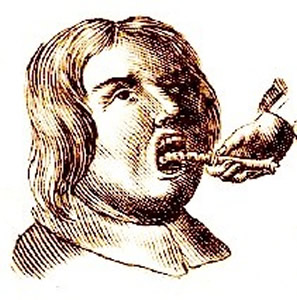
Performing Surgical Work in the Mouth, From L'Arcenal
de Chirurgie, By Johannes Scultetus (17th century)
Carelessness and Neglect of the Mouth... [that] the muscular Parts ha[ve] united to the lower Gums... making all stiff, and the Mouth opening [only] a very little way"18. Moyle simply warns that the surgeon must "have a care (if it ulcerates) least the Cheek and Gum grow together"19.
Atkins says that the problem "is owing to neglect in cleansing the Mouth often, Cold, but chiefly the Tortness of the Flannel Bandages and Wrappers for so long a Time ."20 He talks about cutting the united pieces apart, noting that this gave him "a great deal of Trouble in dividing them with a Knife, and keeping them separated afterwards with thin Pieces of Linen diped in Gargle between; and after all, became little better, remaining stiff and contracted."21 Moyle recommends preventing this by having "the Patient stir the Tongue often, to hinder the growing."22 Based on his estimation of the problem Atkins suggests the surgeon "slacken such [over tight] bandages betimes, especially if the Patient is old; and keep ...the Gargles continually using, Frictions, and Oiley Embrocations."23
1,2 John Atkins, The Navy Surgeon, 1742, p. 244; 3 Atkins, Navy Surgeon, p. 247; 4 Atkins, Navy Surgeon, p. 244-5; 5 Atkins, Navy Surgeon, p. 245; 6 Atkins, Navy Surgeon, p. 246; 7 Atkins, Navy Surgeon, p. 247; 8 Matthias Gottfried Purmann, Churgia Curiosa, 1706, p. 195; 9 Edward Phillips, The New World of Words, 1706, not paginated - Pelagians - Pendulum; 10 Atkins, Navy Surgeon, p. 245-6; 11 John Moyle, Chirugius Marinus: Or, The Sea Chirurgeon, 1693, p. 150; 12 Moyle, Chirugius Marinus, p. 149; 13 Moyle, Chirugius Marinus, p. 150; 14,15 John Moyle, Memoirs: Of many Extraordinary Cures, 1708, p. 88; 16 Moyle, Memoirs, p. 97; 17 Moyle, Memoirs, p. 98; 18 Atkins, Navy Surgeon, p. 246-7; 19 Moyle, Chirugius Marinus, p. 150; 20,21 Atkins, Navy Surgeon, p. 247; 22 Moyle, Chirugius Marinus, p. 150; 23 Atkins, Navy Surgeon, p. 247
Treating VD During the GAoP: Gummas
Historian Claude Quétel explains that once
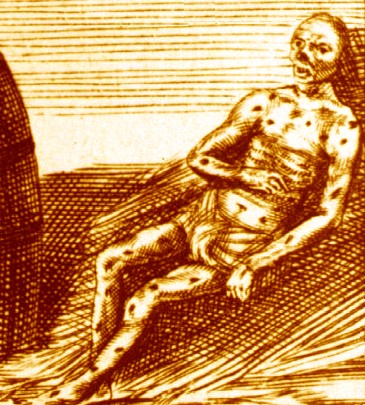
A Man With 3rd Stage Skin Lesions on his Body and Gumma-Caused
Loss of His Nose, From Die Belagertund Entsetzte Venus (1689)
the body had been penetrated by the disease, large rounded tumours start to appear at random in muscles or bones, eating away cavities within them. At first they are hard, but they soften into a whitish and viscous substance (hence the term gumma, used from this time onwards); they ulcerate the body extensively, exposing the bones and eating away at the nose, the lips, the palate, the larynx and the genitals.1
Gummas are today recognized as a symptom of the modern third stage of syphilis. Here was the culprit responsible for the horrible syphilitic disfigurements, chief among which is the missing nose. Naval physician William Cockburn includes gummas in his description of gonorrhea. (Gummas actually have nothing to do with the modern understanding of gonorrhea, but given that period medical men barely distinguished between gonorrhea and syphilis, lumping them all together, this makes sense.) Cockburn calls them 'Crystalins' and says they are "the Effect of the Unfitness of the Parts of Generation"2.
Most of the period authors under study recommend methods for curing gummas. The one exception is John Atkins, who blames them on the use of mercury in curing the Pox and suggests they will go away when the mercury is stopped.3 Cockburn says gummas "are cured only by Topical Medicines, without have any regard to a Gonorrhœa, a Shanker, or any other of its Symptoms."4 He explains that the medicines used are astringent, capable of bringing the rent skin back together. His recommendations for topical medicines include:
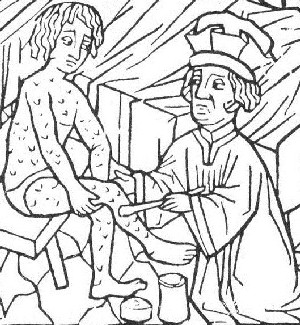
Medicating the Pox in Venice, Bartholomaus Steber (1498)
Rx. Aq. Calc[is]. [lime water or diluted calcium hydroxide - recognized for its ability to dry and cleanse ulcers] {3 ounces} Spir. Vini Gallica [French spirit of wine] {2 ounces} M. [mixed] et foveature Pars affecta tepide [keep the part affected warm] quator vel quinquies in Die [and apply four or five times a day].
Rx. Folior. Absynth. [wormwood leaves - considered powerful curing and drying medicine] {one handful} Hor[dium]. [barley] Chamemæl [chamomile leaves - good for cleansing ulcers] sambuc. [elder leaves - thought to dissipate poison in the body] {of each, half a handful} Coq. in [boil in] aq. Calc[is]. {1.5 pounds} ad 1/3 Comsumptionem. [until 1/3 is consumed] Colaturæ [strain] per expressionem factæ [through the expression of] add. Spir. Vin. [added spirit of wine] {6 ounces}.5
Cockburn says that once the gummas begin to heal, the medicines can be made more astringent by adding blue vitriol or Aqua Opthalmica Sapphirina (blue eye water) which contained lime water and ammonium choloride. He specifically advises not to use inward medicines.
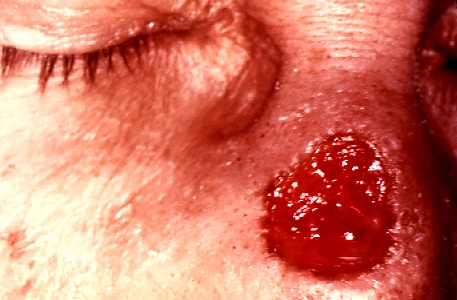
Photo: CDC - Syphilitic Gumma on the Nose
German surgeon Matthias Gottfried Purmann says that syphilitic ulcers are to be treated topically "with the Decoction which the Patient drinks (diet drink), or some proper Vulnerary [healing] Water"6. He elsewhere advises changing the patient's room, bed and clothes and using an opodeldoch plaster on the ulcers when they are not 'perfectly whole'. The opodeldoch plaster was used to heal wounds. However, he warns that "if the Bones are foul or rotten, you must scrape them well, and then cleanse them with Phlegm [first material that comes from distillation] of Vitriol, for before this is done they will never heal"7. Removing rotted parts was a standard procedure when the bones had become decayed.
Sea surgeon John Moyle talks about gummas and other skin conditions, but only in his Memoirs. Most of his recommendations revolve around the use of standard treatments for a Confirmed Pox: purges, sweating and salivation. He does mention the presence of gummas in several of his case studies
o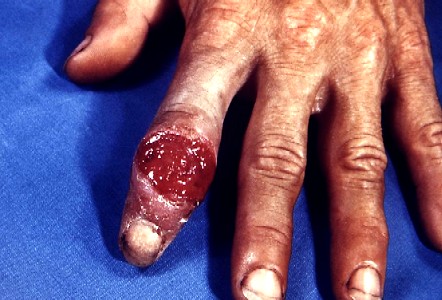
Photo: CDC - Syphilitic Gumma on Left Index Finger
8, but beyond the standard pox treatments, he doesn't usually address their individual treatment. In addition to the above, he suggests purging unwanted humors from the body using Calomel (which contains mercury) and conserve of borage9, but this remedy does not specifically treat gummas. The single topical he does discuss is a catch-all medicine for skin scaling, gummata and syphilitic nodes. This is the same as his complex gargle for treating lesions in the mouth "with addition of Mel. Egyptiac. [Egyptian honey - used to cleanse ulcers] Parum. [lesser] and the Gummata or Nodes were stuped therewith."10 This was to be used in combination with enemas, blood-letting, purging and salivation.
Sea surgeon Hugh Ryder similarly noted when faced with a venereal patient having wounds on the head, arms and breast, he put the man "upon a course of antivenereal Pills, and diet Drink, in three days time there was laudable digestion, and in a short time his Ulcer and Wounds were perfectly healed"11. He kept the patient on this diet for three weeks after the wounds had healed, "believing it more safe in such cases, rather to over than underdo."12
1 Claude Quétel, History of Syphilis, 1990, p. 27; 2 William Cockburn, The Symptoms, Nature, Cause and Cure of a Gonorrhoea, 1713, p. 83; 3 John Atkins, The Navy Surgeon, 1742, p. 248; 4 Cockburn, p. 165; 5 Cockburn, p. 167; 6,7 Matthias Gottfried Purmann, Churgia Curiosa, 1706, p. 195; 8 For examples, see John Moyle, Memoirs: Of many Extraordinary Cures, 1708, p. 93 & 96; 9 Moyle, Memoirs, p. 93; 10 Moyle, Memoirs, p. 98; 11,12 Hugh Ryder, New Practical Observations in Surgery Containing Divers Remarkable Cases and Cures, 1685, p. 15

